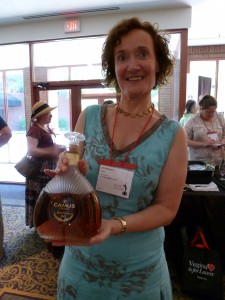Cognac: Not Just For Rap Stars
 Cognac can be easy to dismiss as the purview of either grey-haired blue bloods or freewheeling young hip-hop fans. But those who subscribe to that view miss an obvious point: Cognac must be something quite special to appeal to both the château and the crib sets.
Cognac can be easy to dismiss as the purview of either grey-haired blue bloods or freewheeling young hip-hop fans. But those who subscribe to that view miss an obvious point: Cognac must be something quite special to appeal to both the château and the crib sets.
Cognac is a type of brandy made, as you might have guessed, in and around the city of Cognac in France. It must be double-distilled from white wine, 90% of which must be Ugni Blanc (Trebbiano), Colombard and Folle Blanche. The grapes for this wine can come from a range of favorable or less favorable growth zones. Grande Champagne and Petit Champagne (not to be confused with the sparkling wine region) tend to be the best, and anything with “Bois” in the name tends to be less impressive.
Just as important, Cognacs are graded according to age. In order from youngest to oldest, the grades are V.S., V.S.O.P. and X.O. But just to keep you on your toes, Cognac can also be labeled as Napoleon, Extra, Vieille Reserve and Hors d’Âge, indicating an age greater than X.O., or simply Vieux (literally “old”), which falls somewhere between V.S.O.P. and X.O.
Those marketing Cognac to non-French consumers might wish to consider simplifying this system a bit.
At the recent Wine Bloggers Conference in Charlottesville, Virginia, I had the opportunity to taste three Cognacs, presented by the very charming and down-to-earth Evelyne Resnick. She clearly enjoyed the Cognac she served, but there was no elitism or snobbery about the product — she just made it seem fun to drink.
The Courvoisier (aged eight years in oak barrels) tasted mellow and rich, and the glorious Camus Borderies (aged 35-40 years in oak) coated the tongue in smooth elegance, restraining its alcohol punch until the very last moment.
But the older Courvoisier starts at $50, and the Camus costs over $100. Worth it, perhaps, but that’s a fair chunk of change. I also tasted a less expensive Cognac: Bache Gabrielsen 3 Kors, crafted by a transplanted Scandinavian family. I couldn’t find an age designation on the label, but its website indicated an age of “around four years” (equivalent to V.S.O.P.). At about $30 a bottle, it’s eminently affordable and decidedly delicious.
This younger Cognac smelled like most brandies, with some vanilla and oak, but there was something fresh and green in the nose as well. It tasted very smooth at the front of the tongue, exercising judicious power only at the mid- and rear palates. This Cognac lets you know it’s 40% alcohol without making you wince. Elegant and light on its feet, the Bache Gabrielsen would make an ideal aperitif, or digestif, or any other tif, for that matter.
Dr. Resnick explained that the Cognac houses want to make Cognac more of an everyday drink, and are therefore encouraging its use in cocktails. I liked drinking it straight up so much, mixing it with anything else seemed unnecessary at best, but in the interests of bloggery, I tried the Bache Gabrielsen in a classic Sidecar.
This vintage cocktail combines two parts brandy, one part triple sec and one part lemon juice, shaken with ice and strained into a martini glass. Some sugar-coat the rim of the glass, but I prefer my rim unsullied. A Sidecar made with this Cognac was pure delight — bright and citrusy with a round, darkly sweet underbelly. A beautifully balanced drink.
So the next time you feel tempted to buy some brandy, bourbon or whiskey, try picking up a bottle of Cognac instead. Your inner saggy-panted aristocrat will thank you.





